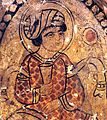Druze facts for kids

Druze star
|
|
| Total population | |
|---|---|
| ≈800,000–2,000,000 | |
| Founder | |
| Hamza and Al Hakim | |
| Regions with significant populations | |
| 600,000 | |
| 200,000 | |
| 150,000 | |
| 20,000 | |
| 60,000 | |
| 50,000 | |
| 25,000 | |
| 20,000 | |
| 14,000 | |
| Religions | |
| Unitarian Druze | |
| Scriptures | |
| Epistles of Wisdom (Rasa'il al-hikma) | |
| Languages | |
The Druze are a unique group of people who speak Arabic. Most of them live in the Middle East, especially in countries like Syria and Lebanon. Many Druze have also moved to other parts of the world, including the United States and Canada. There are more than 500,000 Druze people around the globe.
The Druze follow a special religion that shares some ideas with Islam and Christianity. However, it focuses more on philosophy and deep thinking.
Contents
Who Are the Druze People?
The Druze are an Arabic-speaking community. They live mainly in the Middle East. They have a unique culture and a strong sense of community.
Where Do Druze People Live?
Most Druze live in Syria and Lebanon. You can also find large Druze communities in Israel and Jordan. Many Druze have moved to countries like the United States, Canada, and Australia. This means you can find Druze people all over the world.
What Do Druze Believe?
The Druze religion is called Tawhid, which means "Unitarianism." It teaches that God is one and unique. Their beliefs are kept secret from outsiders. This is why many Druze do not try to convert others to their religion.
The religion was started in the 11th century. A ruler of Egypt named Al-Hakim supported its creation. The main founder was a preacher named Hamza bin Ali. The name "Druze" likely comes from another preacher, Darazi. He was later expelled from the movement.
Druze History and Influence
The Druze have played an important role in the history of the Middle East. In Lebanon, they had a lot of political power. They were even rulers of Mount Lebanon before the 1860s.
After 1860, they shared power with another group called the Maronites. When Lebanon became independent, the Druze were recognized as one of the four main religious groups. They have continued to be important in Lebanese politics. For example, they gained more representation in the government in the early 1990s.
Images for kids
-
Sixth Fatimid caliph, al-Hakim bi-Amr Allah
-
Druze woman wearing a tantour during the 1870s in Chouf, Ottoman Lebanon
-
Meeting of Druze and Ottoman leaders in Damascus, about the control of Jebel Druze
-
Druze dignitaries celebrating the Nabi Shu'ayb festival at the tomb of the prophet in Hittin, Israel.
-
The Druze Maqam al-nabi Yahya (John the Baptist) in As-Suwayda Governorate.
-
Jethro shrine and temple of Druze in Hittin, northern Israel
-
Druze Prayer house in Daliat al-Karmel, Israel
-
Druze sheikh (ʻuqqāl) wearing religious dress
-
Shuaib (Jethro) grave near Hittin, Israel: Both religions venerate Shuaib.
-
Christian Church and Druze Khalwa in Shuf: Historically; the Druzes and the Christians in the Shuf Mountains lived in complete harmony.
-
The Druze Maqam Al-Masih (Jesus) in As-Suwayda Governorate: Both religions revere Jesus.
See also
 In Spanish: Drusos para niños
In Spanish: Drusos para niños






















